| The Libyan Army | |
|---|---|
| الجيش الليبي | |
 Libyan Army Flag | |
| Active | 1951 (Cyrenaica Liberation Army) 2016 (current form) |
| Country | |
| Allegiance |
Formerly |
| Type | Army |
| Role | Land warfare |
| Size | |
| Part of | Libyan Armed Forces |
| Garrison/HQ | Tripoli |
| Colors | Black, red |
| Commanders | |
| Commander-in Chief | Mohamed al-Menfi |
| Chief of General Staff | Mohammad Ali al-Haddad |
The Libyan Army[2] (Arabic: الجيش الليبي) is the brand for a number of separate military forces in Libya, which were under the command of the internationally recognised Government of National Accord (GNA) and the Government of National Unity.
Since December 2015 the groups of the Libyan Army has been nominally subordinated to the internationally recognised Government of National Accord (GNA) based in Tripoli. Due to the instability in the country in 2011 civil war and the outbreak of a new conflict in 2014, the Libyan ground forces remain structurally divided, with components constituting the Tobruk-based Libyan National Army (LNA) under the command of Khalifa Haftar.[3] The forces loyal to the GNA have been fighting against various other factions in Libya, including the Islamic State.[4][5] Some efforts have been made to create a truly national army, but most of the forces under the Tripoli government's command consist of various militia groups, such as the Tripoli Protection Force, and local factions from cities like Misrata and Zintan.[6][7]
Organization
There are two main warfare organizations in Libya: GNA Libyan army and LNA. The other major military force in Libya is the Libyan National Army (LNA), which in 2014 evolved from what was originally called the LNA in 2011 following the fall of Muammar Gaddafi. In 2014, the LNA came under the control of Marshal Khalifa Haftar and the House of Representatives, whose geographical location is in the eastern Libyan city of Tobruk.
In 2017, there was no truly unified army or air force under the Presidential Council's command, and only the Libyan Navy was fully operating under the GNA's control.[8] The Tripoli government aimed to integrate many different militia groups into a regular command structure,[4][9][10] and created a Presidential Guard. Prime Minister Sarraj hold the role of supreme commander of the army.[11] The Libyan Army is commanded by the GNA Defense Ministry, which was initially led by Colonel Al-Mahdi Al-Barghathi from 2016[12] until he was removed in July 2018, at which point GNA Prime Minister Fayez al-Sarraj took on the role of defense minister.[13][7] The Chief of the General Staff was Major General Abdel Rahman al-Taweel,[8] from September 2017 until his removal in February 2019, being replaced by Lieutenant General Mohammed al-Shareef.[14]
2017–2018
Since the establishment of the Government of National Accord in 2016 clashes continued to occur between different factions in Tripoli nominally loyal to the new UN-backed unity government, leaving hundreds dead. Khalifa al-Ghawil proclaimed the creation of a new government consisting of the former General National Congress.[15] Elements of the Presidential Guard defected to the rebels and took over key buildings in the capital.[16][17] Pro-GNA forces eventually were able to defeat the GNC coup attempt.[18][19] Around mid-2017, militias allied to the GNA fully secured the capital. In August 2018 fighting broke out between different groups in Tripoli that were all nominally subordinated to the GNA's defense ministry, forcing Prime Minister Sarraj to call in other militias from different towns outside the capital. A unit called the 7th Brigade had rebelled, leading to its dissolution.[7][20]
2019
On 6 April 2019, a joint operations room was formed in response to Khalifa Haftar's attack on Tripoli to coordinate their military forces. It is led by Western military zone commander Osama al-Juwaili and includes the heads of the Tripoli and Central military zones, the Counter-Terrorism Force, and representatives from the Presidential Guard and Military Intelligence Bureau.[11]
In response to a common interest in defending Tripoli against the LNA, the armed militias that in mid 2019 composed the armed forces of the GNA coordinated with one another mainly by agreement among armed group commanders rather than by the official command structure. The militias remained mostly autonomous in decision-making while formally being integrated into the GNA chain of command. Lacher Wolfram, writing in a Security Assessment in North Africa publication, described this as "bottom-up integration" and a "remarkable development" that "could potentially serve as a starting point for the creation of properly integrated forces ... [with] loyalty to a unified command structure".[1]
Military zones
On 1 June 2017, the GNA announced the creation of seven military zones throughout Libya. They include Tripoli, Benghazi, Tobruk, Sabha (Southern), Kufra, Central (from Misrata to Zuwetina), and Western (west of Tripoli to Jebel Nafusa) . The commanders of each zone were responsible for training and preparation of the forces in their area and answered to the Libyan army chief of staff. Not all of the territories accounted for were under the GNA's control at the time.[21][22][23]
The leaders of the military zones are as follows.
- Tripoli: Maj. Gen. Abdel Basset Marwan (from 14 March 2018) – Militia leader from Tripoli.[10][24][25]
- Western: Maj. Gen. Osama al-Juwaili (from 4 June 2017) – Zintan military council leader.[22][25]
- Central: Maj. Gen. Mohammed al-Haddad (from 4 June 2017) – Halbous Brigade leader from Misrata.[22]
- Southern (Sabha): Ali Kanna (from 6 February 2019) – Tuareg militia leader.[25][26]
- Kufra: Brig. Belgasim al-Abaj – tribal leader from Kufra.[27]
Known units
- Tripoli Protection Force
- Shura Council of Benghazi Revolutionaries
- Libya Shield Force
- Petroleum Facilities Guard
- Tuareg militias in Fezzan[28][29]
- Tripoli Revolutionaries Brigade[30]
- Abu Saleem Central Security Force[31]
- Omar Mukhtar force: 2000 Syrian National Army mercenaries funded at US$2,000 per month arriving in December 2019/January 2020; 650 arrived in Libya by 29 December and deployed to frontline positions in East Tripoli.[32]
- Turkish military advisory personnel: 35 as of 15 January 2020[32]
Allies
One of the GNA main allies is Turkey. Turkey had deployed weapons and equipment to GNA troops even before the Government of National Accord (GNA) requested Turkish military support in December 2019.[33] Turkey's engagement for the GNA is linked to its broader strategic interests in the Eastern Mediterranean: in November, Turkey and GNA leader Fayez al-Serraj signed a defense cooperation deal. At the same time GNA and Turkey agreed one on maritime boundaries in the Eastern Mediterranean, where Turkey is locked in a dispute with regional rivals Greece, Cyprus, Egypt and Israel over access to sea regions rich in natural gas.
Equipment
Weapons
| Model | image | type | Calibre | Quantity | Origin | Notes | |
|---|---|---|---|---|---|---|---|
| Pistol | |||||||
| TT-33[34] | 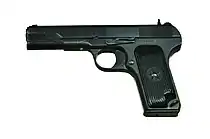 |
Semi-automatic pistol | 7.62×26mm | ||||
| Makarov PM[35] |  |
Semi-automatic pistol | 9x18mm Makarov | ||||
| Browning Hi-Power[36] | .jpg.webp) |
Semi-automatic pistol | 9mm parabellum | ||||
| Glock 17 |  |
Automatic Pistol | 9mm parabellum | ||||
| SAR 9 |  |
Semi-automatic pistol | 9×19mm Parabellum | ||||
| Caracal F |  |
Semi-automatic pistol | 9x19mm Parabellum | Purchased and issued to the Ministry of Interior of Libya staff.[37] | |||
| Submachine gun | |||||||
| Heckler & Koch MP5[36] |  |
Submachine gun | 9mm parabellum | ||||
| FN P90[38] |  |
Submachine gun | 5.7×28mm | ||||
| Shotgun | |||||||
| Benelli M4 Super 90[39][40] | Semi-Auto Shotgun | 12 gauge | 1800 | An order were delivered prior of the start of the Libyan revolution of 2011, later used by Libyan special forces. | |||
| Winchester Model 1200[41] | 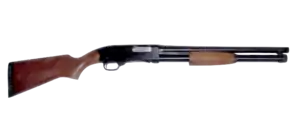 |
Pump-Action Shotgun | 12 gauge | ||||
| Battle rifle and assault rifle | |||||||
| MPT |  |
Battle rifle | 7.62×51mm NATO | MPT-55K assault rifles supplied by Turkey.[42] | |||
| G3[43] |  |
Battle rifle | 7.62×51mm NATO | ||||
| M4A1[44] |  |
Carbine rifle | 5.56×45mm NATO | ||||
| M16[44] |  |
Carbine rifle | 5.56×45mm NATO | ||||
| Heckler & Koch G36[45][46][47][48][49] | 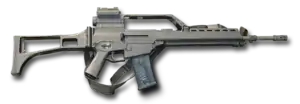 | Assault rifle | 5.56×45mm NATO | 600 | G36 (variants KV and E) were legally sold from Egypt in 2003, pressumably used by the Khamis Brigade/Special Forces (although this remains unclear), anti-Gaddafi forces, most notably the Tripoli Brigade, would later capture an unknown number of stockpiled G36 from the Bab al-Azizia armory. | ||
| AK-47[50] |  |
Assault rifle | 7.62×39mm | ||||
| AKM[51] |  |
Assault rifle | 7.62×39mm | ||||
| AK-103[52] |  |
Assault rifle | 7.62×39mm | Formerly used by Gaddafi Loyalists and later captured by anti-Gaddafi forces. | |||
| PM md. 63[53] |  |
Assault rifle | 7.62×39mm | ||||
| Zastava M70[36] |  |
Assault rifle | 7.62×39mm | ||||
| Norinco CQ[54] | Assault rifle | 5.56×45mm NATO | Chinese unlicensed copy of M16 Rifle, used by the National Liberation Army. | ||||
| Type 65[55] |  |
Assault rifle | 5.56×45mm NATO | Taiwanese copy of the M16 Rifle. | |||
| Beretta AR70/90 |  |
Assault rifle | 5.56×45mm NATO | ||||
| FN F2000[56][57] | 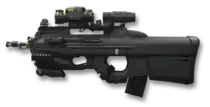 |
Bullpup assault rifle | 5.56×45mm NATO | 367 | Purchased from FN Herstal in 2008, delivery commenced in 2009, durning the Libyan Civil War of 2011, Libyan rebels captured an unknown number of F2000 from Gaddafi loyalists. | ||
| FN FAL[36] |  |
Battle rifle | 7.62×51mm NATO | ||||
| Sniper rifle | |||||||
| M82 |  |
Sniper rifle | 50 BMG | ||||
| SVD Dragunov[51] |  |
Sniper rifle | 7.62×54mmR | ||||
| PSL[58] |  |
Sniper rifle | 7.62×54mmR | Formerly used by anti-Gaddafi forces. | |||
| Machine gun | |||||||
| PK machine gun[36] |  |
General-purpose machine gun | 7.62×54mmR | ||||
| RPK[34] |  |
Light machine gun | 7.62×39mm | ||||
| RPD[34] |  |
Light machine gun | 7.62×39mm | ||||
| FN Minimi[59][36] |  |
Light machine gun | 5.56×45mm | ||||
| FN MAG[36] |  |
General-purpose machine gun | 7.62×51mm | ||||
| M2 Browning[44] |  |
Heavy machine gun | 12.7 mm | ||||
| DShK[43] |  |
Heavy machine gun | 12.7 mm | ||||
| Grenade-based weapon | |||||||
| GM-94 |  |
Pump-action grenade launcher | 43×30mm | Used by anti-Gaddafi forces.[60] | |||
| Daewoo K4[61] |  |
Automatic grenade launcher | 40mm | First export customer | |||
| Anti-tank weapons | |||||||
| RPG-7[34] |  |
Rocket-propelled grenade launcher | 40mm | Used by both sides durning the Libyan Civil War. | |||
| M40 recoilless rifle[62] |  |
Recoilless gun | 105mm | US, Chinese and Iran made variants used. | |||
| SPG-9[62] |  |
Recoilless gun | 73mm smoothbore | ||||
| 9M14 Malyutka[63] | 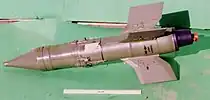 |
Anti-tank guided missile | 125mm | ||||
| 9K115 Metis |  |
Anti-tank guided missile | 94mm | Supplied by Turkey to the GNA.[64] | |||
| MILAN |  |
Anti-tank guided missile | 115mm | Supplied by Qatar during the 2011 Libyan Civil War.[65] | |||
Artillery
| Name | Image | Type | Origin | Quantity | Notes | |
|---|---|---|---|---|---|---|
| Rocket artillery | ||||||
| Type 63 multiple rocket launcher |  |
107mm MLRS | 1+ | Some were captured from the LNA.[66] | ||
| BM-21 Grad |  |
122mm MLRS | 4+ | Some were captured from the LNA.[66] | ||
| T-122 Sakarya[67] | .JPG.webp) |
122mm MLRS | 20+ | Supplied by Turkey | ||
| Self-propelled howitzer | ||||||
| 2S1 Gvozdika |  |
122mm | 1+ | Formerly used by Gaddafi forces. Some were captured from the LNA.[66] | ||
| Palmaria[68] | 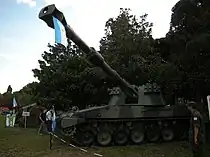 |
155mm | 9+ | Some were captured from the LNA.[66] | ||
| T-155 Fırtına | 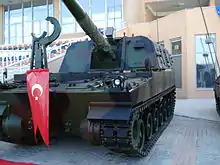 |
155mm | Unknown amount supplied by Turkey.[42] | |||
| Towed howitzer | ||||||
| M114 | _155_mm_Towed_Howitzer.jpg.webp) |
155mm | Donated to the Libyan Army by Turkey.[69] | |||
| D-30[68] |  |
122mm | 2+ | Some were captured from the LNA.[66] | ||
| M-46 |  |
130mm | 6 | Captured from the LNA.[66] | ||
| Mortar | ||||||
| M1938 |  |
120mm | Unknown | Used by anti-Gaddafi Forces during the 2011 Libyan Civil War.[70] | ||
| Anti-aircraft systems | ||||||
| ZPU | 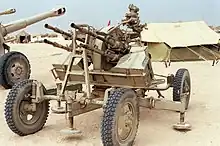 |
14.5mm Anti-aircraft gun | Used by both sides durning the 2011 Libyan Civil War.[71] Mounted on technicals.[68] | |||
| ZU-23-2 |  |
23mm Anti-aircraft gun | Mounted on technicals.[68] | |||
| ZSU-23-4 |  |
23mm Self-propelled anti-aircraft gun | Used by both sides durning the 2011 Libyan Civil War.[72] | |||
| KORKUT | 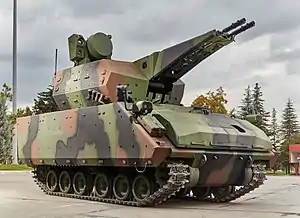 |
35mm Self-propelled anti-aircraft gun | Supplied by Turkey.[42] | |||
| QW-13 |  |
Man-portable air-defense system | [68] | |||
| MIM-23 Hawk |  |
Surface-to-air missile system | Supplied by Turkey.[42] | |||
Vehicles
| Model | Image | Origin | Variant | Number | Details |
|---|---|---|---|---|---|
| Main battle tanks | |||||
| T-54/T-55[68] |  |
T-55A T-55E |
59+ | Some were captured from the LNA.[66] | |
| T-62 | .jpg.webp) |
T-62M T-62MV |
20 | Captured from LNA forces.[66] | |
| T-72[68] |  |
T-72 T-72M1 |
3+ | Some were captured from LNA forces.[66] | |
| M60 Patton |  |
M60A1 | 3 | Supplied by Turkey.[42][73] | |
| Infantry fighting vehicles | |||||
| BMP-1 | _(8289625370).jpg.webp) |
Some were captured from the LNA.[66] | |||
| BMP-2[68] |  |
||||
| Ratel IFV | .jpg.webp) |
Ratel 20 Ratel 60 |
2 | Captured from the LNA.[66] | |
| Armored cars | |||||
| EE-9 Cascavel |  |
2+ | Some were captured from the LNA.[66] | ||
| Armoured personnel carriers | |||||
| FNSS ACV-15[68] | .JPG.webp) |
ACV-AAPC | Supplied by Turkey.[69] | ||
| Steyr 4K-7FA[68] | |||||
| Mbombe 6[68] |  |
||||
| KADDB Al-Wahsh[68] |  |
5+ | Captured from the LNA.[66] | ||
| BMC Kirpi[68] |  |
Kirpi II | Supplied by Turkey.[69] | ||
| BMC Vuran[68] |  |
Supplied by Turkey.[69] | |||
| Lenco BearCat[68] | .jpg.webp) |
G3 | |||
| Nimr[68] | .JPG.webp) |
Ajban | 1+ | Captured from the LNA.[66] | |
| STREIT Group Cougar |  |
4 | Captured from the LNA.[66] | ||
| STREIT Group Spartan | 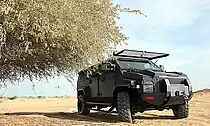 |
3 | Captured from the LNA.[66] | ||
| Panthera T6 |  |
3 | Captured from the LNA.[66] | ||
| Panthera F9 | 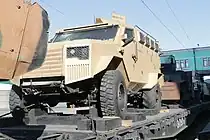 |
1 | Captured from the LNA.[66] | ||
| HMMWV | .tiff.jpg.webp) |
3+ | Part of a batch of 200 vehicles sent by the US to Libya in 2012. Some were captured from the LNA.[66] | ||
| Military engineering vehicles | |||||
| Centurion AVRE[68] | 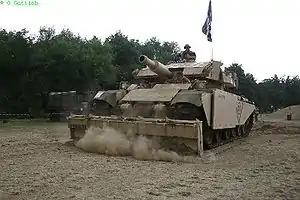 |
AVRE 105 | |||
| Tank destroyers | |||||
| 9P157-2 Khrizantema-S[68] | 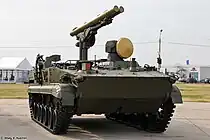 |
||||
| Trucks | |||||
| Toyota Land Cruiser | .jpg.webp) |
HZJ 79 | Used as technicals.[74] | ||
| Iveco Trakker | .jpg.webp) |
Trakker 380 | 1 | Captured from the LNA.[66] | |
| KAMAZ | 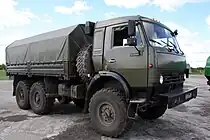 |
? | 2 | Captured from the LNA.[66] | |
References
- 1 2 3 Lacher, Wolfram (2019). "Who is fighting whom in Tripoli? How the 2019 civil war is transforming Libya's military landscape" (PDF). Security Assessment in North Africa Briefing Paper. Archived from the original (PDF) on 10 November 2019. Retrieved 11 November 2019.
- ↑ Assad, Abdulkader (8 October 2019). "Al-Sarraj orders military support for Libyan Army forces on frontlines". The Libya Observer. Archived from the original on 15 November 2019. Retrieved 15 November 2019.
- ↑ Ali H. M.Abo Rezeg (20 March 2018). Cairo eyes unification of Libyan military establishment. Anadolu Agency.
- 1 2 Lewis, Aidan (31 August 2016). Libyan forces prepare for last push against Islamic State in Sirte. Reuters.
- ↑ Nicholas Norbrook (22 June 2016). Libyan army gains ground against IS in Sirte. The Africa Report.
- ↑ Wehrey, Frederic (19 March 2019). A Minister, a General, and the Militias: Libya's Shifting Balance of Power. The New York Review of Books.
- 1 2 3 Dozens dead after days of clashes near Libyan capital. France24. Published 31 August 2018.
- 1 2 Serraj appoints military chief of staff. Libya Herald. Published 1 September 2017.
- ↑ Szuba, Jared (5 April 2019). Haftar's Libyan National Army advances on Tripoli as western militias mobilize. The Defense Post.
- 1 2 Pro-Karah Office Tipped for Top Military Post. The Libya Times. Published 14 March 2018.
- 1 2 PC President forms joint military operations room as war rocks Tripoli yet again. Libya Observer. Published 6 April 2019.
- ↑ Ayyub, Saber.Opposing reactions to appointment of unity government’s defence minister Archived 18 August 2016 at the Wayback Machine. Libya Herald. Published 21 January 2016.
- ↑ Libyan Presidential Council gives its Defense Minister the sack. Libya Observer. Published 29 July 2018.
- ↑ Lieutenant General Mohammed Al-Sharif takes office as Libya's Chief of Staff. Libya Observer. Published 14 March 2019.
- ↑ "Clashes erupt in Libyan capital". The Washington Post. Archived from the original on 16 October 2016. Retrieved 16 November 2016.
- ↑ "Rival group seizes Libya's UN-backed government offices". Archived from the original on 22 October 2016. Retrieved 16 November 2016.
- ↑ "Presidential Guard defects and pledges allegiance to Al-Ghweil Salvation Government". 16 October 2016.
- ↑ "Ceasefire reached in Tripoli after three days of bloody fighting". Libyan Express. 15 March 2017. Archived from the original on 21 August 2017. Retrieved 3 December 2018.
- ↑ "Libya govt forces overrun Tripoli militia headquarters". Agence-France Presse. Arab News. 15 March 2017. Archived from the original on 30 April 2017. Retrieved 3 December 2018.
- ↑ "Notorious militia leader returns to ignite Libya conflict". 30 August 2018. Retrieved 22 April 2019.
- ↑ PC decides to divide the country into seven military zones. Libya Herald. 1 June 2017.
- 1 2 3 PC appoints military commanders. Libya Herald. Published 4 June 2017.
- ↑ Libya to be divided into 7 military zones. Middle East Monitor. Published 2 June 2017.
- ↑ Mahmoud, Khalid (27 May 2018). Libya: Sarraj Discusses Situation in South. Asharq al-Awsat.
- 1 2 3 Fayez al-Sarraj parleys with some Libyan military commanders. PanaPress. Published 4 March 2019.
- ↑ Libya: Al-Sirraj appoints Ali Kanna commander of Sabha military zone. Libya Observer. Published 6 February 2019.
- ↑ Kufra tribes gather for peace and vow support to LNA. Libya Herald. Published 2 May 2018.
- ↑ Carlino, Ludovico (7 February 2019). Appointment of anti-LNA commander in southern Libya indicates Tripoli’s intent to recover territory taken by the LNA. Jane's.
- ↑ Dabbashi: Ali Kanna wanted to grant Libyan nationality to Malian Tuaregs in 2011. Address Libya. Published 7 February 2019.
- ↑ "Tripoli Revolutionaries Brigade seizes Hadba Prison, kills two guards as fighting intensifies". Libyan Express. 27 May 2017.
- ↑ "Renewed militia clashes shake Tripoli". Libya Herald. 16 December 2016. Retrieved 14 January 2017.
- 1 2 McKernan, Bethan; Akoush, Hussein (15 January 2020). "Exclusive: 2,000 Syrian fighters deployed to Libya to support government". The Guardian. Archived from the original on 15 January 2020. Retrieved 17 January 2020.
- ↑ Welle (www.dw.com), Deutsche, Turkish parliament approves sending troops to Libya | DW | 02.01.2020, retrieved 15 January 2022
- 1 2 3 4 Jones, Richard D. (5 January 2009). Jane's Infantry Weapons 2009/2010 (35 ed.). Jane's Information Group. ISBN 978-0-7106-2869-5.
- ↑ "Libyan Makarov". Archived from the original on 25 February 2021.
- 1 2 3 4 5 6 7 Jenzen-Jones, N.R.; McCollum, Ian. "Web Trafficking: Analysing the Online Trade of Small Arms and Light Weapons in Libya" (PDF). Small Arms Survey. Archived from the original (PDF) on 16 May 2017.
- ↑ Morajea, Hassan; Smallwood, Michael (9 March 2015). "Arms diversion in Libya: An update". Armament Research Services (ARES). Retrieved 8 June 2023.
- ↑ Fux, Eric (1 May 2011). "deredactie.be - ANALYSE » Blog Archive » Bericht van het front in Libië". deredactie.be. Archived from the original on 1 May 2011. Retrieved 4 October 2022.
- ↑ "Benelli M4 Super 90 (M1014 JSCS)". www.militaryfactory.com. Retrieved 4 October 2022.
- ↑ Giorgio Beretta Mercoledì, 09 Marzo 2011 (27 February 2011). "L'Italia ha inviato 11mila Beretta semiautomatici al regime di Gheddafi / Notizie / Home - Unimondo". www.unimondo.org. Retrieved 4 October 2022.
{{cite web}}: CS1 maint: numeric names: authors list (link) - ↑ "Winchester Model 1200". www.militaryfactory.com. Retrieved 4 October 2022.
- 1 2 3 4 5 "Turkey continues to send arms to Libya in violation of UN Security Council resolutions - Nordic Monitor". Nordic Research and Monitoring Network. 23 June 2022. Retrieved 18 June 2023.
- 1 2 Jones, Richard D.; Ness, Leland S., eds. (27 January 2009). Jane's Infantry Weapons 2009/2010 (35th ed.). Coulsdon: Jane's Information Group. ISBN 978-0-7106-2869-5.
- 1 2 3 "Libya - SALW Guide". salw-guide.bicc.de. Retrieved 7 October 2022.
- ↑ NACHRICHTEN, n-tv. "Gewehre kommen aus Ägypten". n-tv.de (in German). Retrieved 4 October 2022.
- ↑ NACHRICHTEN, n-tv. "Rebellen nutzen G36-Gewehre". n-tv.de (in German). Retrieved 4 October 2022.
- ↑ NACHRICHTEN, n-tv. "Heckler & Koch schickt Ermittler". n-tv.de (in German). Retrieved 4 October 2022.
- ↑ NACHRICHTEN, n-tv. "Regierung sieht keine Fehler". n-tv.de (in German). Retrieved 4 October 2022.
- ↑ "G36 in use by Trippoli Bridade". Al-Jazera. Archived from the original on 7 July 2012. Retrieved 2 February 2022.
- ↑ Rottman, Gordon L. (24 May 2011). The AK-47: Kalashnikov-series assault rifles. Oxford: Osprey Publishing. ISBN 978-1-84908-835-0. OCLC 773366277.
- 1 2 Jane's infantry weapons, 2009-2010. Richard, August 14- Jones, Leland S. Ness (35 ed.). Coulsdon: Jane's Information Group. 2009. ISBN 978-0-7106-2869-5. OCLC 769660119.
{{cite book}}: CS1 maint: others (link) - ↑ Jenzen-Jones, N. R. (31 October 2011). "Update II: AK-103 Exports to Libya". Security Scholar. Archived from the original on 22 December 2014. Retrieved 14 November 2014.
- ↑ ""World Infantry Weapons: Libya"". Google. Archived from the original on 5 October 2016. Retrieved 4 October 2022.
- ↑ "Small Arms of the 2011 Libyan Conflict – Cataloguing the Weapons of War". The Rogue Adventurer. 12 December 2011. Archived from the original on 8 May 2014. Retrieved 4 October 2022.
- ↑ "T65 (Type 65)". www.militaryfactory.com. Retrieved 7 October 2022.
- ↑ "FN F2000 sold to Gaddafi Regime". Expatica. Archived from the original on 5 July 2012.
- ↑ Taylor, Alan. "DIY Weapons of the Libyan Rebels - The Atlantic". www.theatlantic.com. Archived from the original on 6 January 2015. Retrieved 4 October 2022.
- ↑ "Romanian PSL in use by anti-Gaddafi forces". Designated Marksman. Archived from the original on 28 June 2018.
- ↑ McNab, Chris (2017). The FN Minimi Light Machine Gun: M249, L108A1, L110A2, and other variants. Oxford. ISBN 978-1-4728-1621-4. OCLC 948559502.
{{cite book}}: CS1 maint: location missing publisher (link) - ↑ Popenker, Maxim; Jenzen-Jones, N.R. (September 2015). The Russian GM-94 Grenade Launcher (PDF). Australia: Armament Research Services (ARES). p. 17. ISBN 978-0-9924624-5-1. Retrieved 18 June 2023.
- ↑ "S&T Daewoo Succeeded in First Exporting K4 Automatic Grenade Machine Gun to Libya". S&T Holdings. Archived from the original on 3 March 2020. Retrieved 5 October 2022.
- 1 2 Neville, Leigh (2018). Technicals : non-standard tactical vehicles from the great Toyota war to modern special forces. Peter Dennis. Oxford, UK. ISBN 978-1-4728-2253-6. OCLC 1028955162.
{{cite book}}: CS1 maint: location missing publisher (link) - ↑ "Libya: How the opposing sides are armed". BBC News. 10 March 2011. Retrieved 18 June 2023.
- ↑ Lacher, Wolfram (21 August 2019). Who's Fighting Whom in Tripoli: How the 2019 Civil War is Transforming Libya's Military Landscape. Geneva, Switzerland: Small Arms Survey. p. 14. Retrieved 18 June 2023.
- ↑ Rigual, Christelle (15 December 2014). Armed Groups and Guided Light Weapons: 2014 Update with MENA Focus (Research Note 47). Small Arms Survey. p. 3. Retrieved 13 June 2023.
- 1 2 3 4 5 6 7 8 9 10 11 12 13 14 15 16 17 18 19 20 21 Mitzer, Stijn; Oliemans, Joost. "Disaster at Tarhuna: When Haftar Lost Another Stronghold In Crushing Defeat To The GNA". Oryx. Retrieved 23 December 2023.
- ↑ GDC (31 May 2020). "Turkey Deploys T-122 Sakarya and T-155 Firtina in Libya". Global Defense Corp. Retrieved 6 October 2022.
- 1 2 3 4 5 6 7 8 9 10 11 12 13 14 15 16 17 18 International Institute for Strategic Studies (15 February 2023). The Military Balance 2023 (1st ed.). Routledge. p. 340. ISBN 978-1032508955.
- 1 2 3 4 Oryx. "From Türkiye With Love: Tracking Turkish Military Donations". Oryx. Retrieved 7 October 2022.
- ↑ الثوارعلى مشارف البريقة (01) Ajdabiya 2011.07.17 .MP4 [Rebels in the outskirts of Brega], retrieved 8 October 2022
- ↑ Rawnsley, Adam. "Libya's Got Vlad's Missiles and Kim's Guns". Wired. ISSN 1059-1028. Retrieved 8 October 2022.
- ↑ "ZSU-23-4 (Shilka)". www.militaryfactory.com. Retrieved 8 October 2022.
- ↑ "M60 tanks transferred to Libya". Janes.com. Retrieved 18 June 2023.
- ↑ Spittaels, Steven; Abou-Khalil, Naji; Bouhou, Kassim; Kartas, Moncef; McFarland, David; Servia, Juan Alberto Pintos (12 June 2017). Final report of the Panel of Experts on Libya established pursuant to resolution 1973 (2011) (S/2017/466) (PDF). ReliefWeb. p. 44. Retrieved 24 December 2023.
Further reading
- "Libya's GNA forces announce 'counteroffensive' to defend Tripoli". Al Jazeera English. 8 April 2019. Archived from the original on 14 November 2019. Retrieved 14 November 2019.